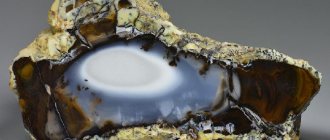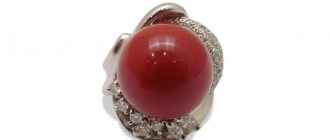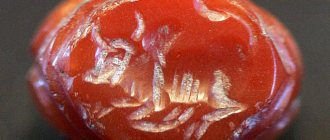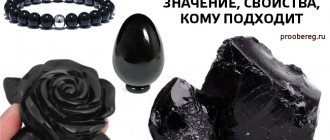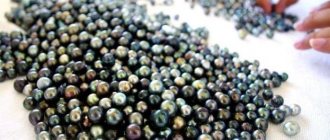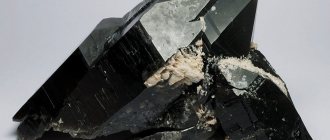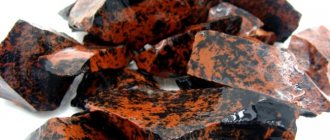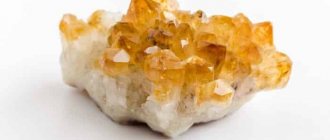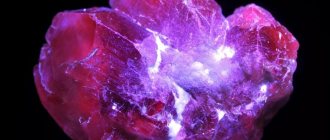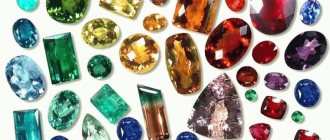| Category | Oxides (minerals) |
| Title in English | Cassiterite |
| Formula | SnO2 |
| Group | Rutile group |
| Color | Yellow, Brown, Red, Black, Colorless |
| Stroke color | Grey |
| Shine | Diamond |
| Transparency | Translucent, Translucent, Opaque |
| singonia | Tetragonal |
| Hardness | 6 — 7 |
| Cleavage | Imperfect |
| Density, g/cm³ | 6,040 — 7,120 |
| Kink | Conchoidal |
| origin of name | The name of this mineral comes from the Greek word kassiteros, which translates as tin. This name was given for a reason, because cassiterite ores are the only type of raw material in the world from which tin is produced on an industrial scale. Tin is used to create tinplate and, for example, to create tin foil. |
| Morphology | Cassiterite is of hydrothermal origin, so this mineral is formed in skarn and vein formations of W-Mo-Sn ores. Also, it appears in geysers, which corresponds to pneumatolytic-hydrothermal. |
Cassiterite is one of the most valuable minerals, tin ore. It began to be mined more than five thousand years ago, when very strong alloys were made from cassiterite, which were widely used by humans. Stone deposits discovered in Great Britain were developed until the end of the twentieth century, when they almost completely dried up. Today, this mineral is mined mainly in Africa and Asia.
Cassiterite deposits
By origin, cassiterites are hydrothermal, pegmatite and igneous.
The formation of large deposits occurs under the influence of high temperatures. — Advertising —
Cassiterite deposits are very widespread. The most ancient of them are in India and Great Britain. Russia is known for its industrial deposits, namely the territory of Transbaikalia, Karelia, Primorsky and Khabarovsk Territories, and Siberia. Jewelry quality specimens are found in Chukotka. Large mines are located in Kazakhstan, the USA, China and Australia. Cassiterites of good gem quality have also been found in countries such as Bolivia, Namibia, Nigeria, Congo and Brazil, Thailand, Malaysia and Canada. Among European countries, mineral mining is carried out in Spain, Portugal, the Czech Republic and France.
Where and how is it mined?
There are no deposits of cassiterite in nature: the mineral for industrial needs is mined from tin ore.
The largest deposits are located in Bolivia, China, Indonesia, and Malaysia.
There are smaller reserves on all continents:
- Europe - Great Britain, Portugal, France, Germany, Czech Republic.
- America – Brazil
- Asia - Tajikistan.
- Africa – Namibia, Nigeria.
- Australia.
In Russia these are Karelia, Transbaikalia, Eastern Siberia, Sakha-Yakutia, Primorye, Chukotka, Magadan region.
Mining is carried out traditionally for ores: open (quarry) or closed (mine) method.
In Chukotka, 10-centimeter cassiterite megacrystals of jewelry or collection grades are found.
History of cassiterite
Cassiterite is also known as tin stone and silesite, and is an oxide.
Its name in Greek means “tin”, since this ore is the basis in the production of metal. The history of the extraction and use of the mineral by humans is very ancient, its roots go back up to 5000 years ago. By combining cassiterite with copper, the famous bronze alloy was created and a new era in metallurgy opened.
As for the mineralogical properties of the stone, its first description dates back to 1832 and belongs to the Frenchman F.S. Byodanu.
Diagnostic signs
Similar minerals. Vesuvianite, tourmaline, sphalerite, ilmenite, wolframite, magnetite, rutile.
In terms of crystal shape, twins and color, it is similar to rutile, and light-colored varieties are also similar to zircon. It differs significantly from them in specific gravity, hardness (for zircon 7–8) and a characteristic slightly greasy or resinous luster at the fracture and a strong diamond shine on the edges. In thin sections, small grains of cassiterite can be mistaken for zircon, whose birefringence is much lower.
Cassiterite with topaz photo
Associated minerals. Typical paragenesis: cassiterite, tourmaline, topaz, lithium micas (lepidolite), lithium-iron micas (zinnwaldite), quartz, apatite, fluorite, arsenopyrite, wolframite, scheelite, molybdenite, native bismuth, chalcopyrite, etc.
Physico-chemical characteristics of cassiterite
— Advertising —
The chemical composition of cassiterite is tin oxide. In small quantities it contains impurities of iron, titanium, magnesium, tantalum and niobium. Its crystals have a tetragonal system, the shape is needle-shaped, dipyramidal, prismatic. The color palette ranges from brown to pitch-black; shades of reddish-brown, red, yellow, gray, greenish are also found in color; colorless specimens are a rare occurrence. The color of the stone is characterized by zoning.
Cassiterite crystals can be either transparent or translucent, or opaque. They are characterized by imperfect cleavage, diamond or greasy luster, and at the fracture they are uneven and conchoidal.
Hardness on the Mohs scale 6-7. Density 6.98-7.01 g/cm3. The stone is fragile, without magnetic properties.
Cassiterite is often included in other types of minerals and is found in them as inclusions.
Crystallographic characteristics
- The syngony is tetragonal.
- Symmetry class. Ditetragonal-bipyramidal c. With. L44L25PC.
- Space group P42/mmm (D144n). a0 = 4.72; c0 = 3.17.
- Axle ratio. s/a = 0.672.
Artificially orthorhombic crystals of SnO2 (with a specific gravity of 6.70) were obtained by Daubray.
Crystal structure. Similar to the structure of rutile (rutile lattice).
It differs in several ways from close-packed oxide structures such as corundum. If in a crystal structure of the corundum type the sheets of the densest packing of oxygen ions are located perpendicular to the triple axis, and in a structure of the spinel type - parallel to the faces of the octahedron (i.e., also perpendicular to the triple axes), then in the crystal structure of the rutile type, as shown by N.V. Belov , the directions of the densest packing in the form of columns are parallel to the main (quadruple) axis of cassiterite crystals. Each Sn ion is surrounded by six oxygen ions located at the corners of an almost regular octahedron. Such octahedra in the crystal structure of cassiterite are elongated along the c axis in the form of rectilinear columns, which sometimes determines the needle-like or columnar appearance of crystals with the directions of the cleavage planes parallel to the elongation of the individuals.
Types of cassiterite
There are several varieties of cassiterite depending on the chemical composition and characteristic features of appearance:
- Ainalites – contain an admixture of ferrotantalites.
- Woody tin is a dense kidney-shaped, cluster-shaped, sintered intergrowth of fine-crystalline cassiterites with a concentric-zonal structure, which in appearance resembles a cut of wood.
- Toad eye - somewhat similar to woody tin, but differs from the latter in its small kidney-shaped structure. They are very widely used by jewelers, as they polish well.
origin of name
Photo of cassiterite with tourmaline
From the Greek “kassiteros” - tin
- Chemical composition
- Crystallographic characteristics
- Form of being in nature
- Physical properties
- Chemical properties
- Diagnostic signs
- Origin of the mineral
- Place of Birth
- Practical use
- Physical research methods
- Crystal optical properties in thin preparations (sections)
- Buy
Magical properties of cassiterite
Cassiterite is one of the few minerals that completely falls under the power of its owner.
It becomes part of his image so much that he can help in any situation, just to please the desire of his owner. At the same time, the stone exhibits such high power and influence that it even sometimes prevents a person from behaving honestly and decently and from changing his bad habits. It is interesting that even practicing magicians and mediums never use cassiterite in their rituals, because it has no effect on the destinies of other people except its owner.
In general, cassiterite attracts good luck and good attitude from people to ambitious and decent people, and helps to find loyal and true friends.
Origin and location of the mineral
Cassiterite ore occurrences and tin deposits are mostly genetically associated with granite intrusions (with tin-bearing granites). In this case, cassiterite is usually confined to formations of the post-magmatic stage: pegmatite, pneumatolite or hydrothermal. During the formation of cassiterite, an important role is played by such volatile components as fluorine, boron, chlorine, which are part of the most important accompanying minerals - topaz (fluorine), tourmaline (boron), apatite (chlorine). Numerous types of greisen are tin-bearing: mica, topaz, tourmaline, etc.; with a high cassiterite content they are called cassiterite greisens. In addition, tin-bearing granites can undergo autometamorphism under the influence of their own volatile components. In such cases, cassiterite in association with topaz, tourmaline and quartz occurs in small stock-shaped bodies that often “overwhelm” the granite massif. Such rocks are called zwitter - they are solid tin ore.
The healing properties of cassiterite
The healing properties of cassiterite are associated with a positive effect on the emotional background; the stone improves mood, suppresses anger and irritability. Jewelry and amulets made from the mineral are very effective in this regard; it is recommended to wear several of them on different parts of the body at once.
In order to increase vitality and activity, rings with cassiterite are worn on the right hand, on the ring finger. A cassiterite bracelet will help normalize blood pressure and prevent strokes. In addition, the stone has a good effect on the functioning of the kidneys and genitourinary system, and is used in the prevention of urolithiasis. For this purpose, cassiterite crystals are placed on the waist and left for 2-3 hours every day for a month.
How to wear and care
Cassiterite is not particularly strong and is fragile. Therefore, you need to take care of it and use “dendritic tin” carefully:
- Do not wear jewelry with stones to the beach, sauna, bathhouse, or swimming pool.
- Remove rings and bracelets before homework.
- Do not store products in direct sunlight.
- Clean the inserts with a soft cloth or sponge and soap.
It is prohibited to clean the stone with abrasives or aggressive household chemicals.
- Don't drop it.
- Don't wear jewelry all the time.
Give them a separate opaque box or a niche in a common box so that the “river tin” does not get scratched.
Applications of cassiterite
Cassiterite is the main ore for the extraction of tin, which in turn is a valuable industrial raw material.
Titanium, bronze and antifriction alloys, as well as solders and tinplate are made from tin. This metal is necessary for welding work and is used for the needs of the glass industry. Decorative elements for interior design are made with its use. As for jewelry, cassiterite is also popular in this matter due to its high strength and refractive index, beautiful diamond luster and rich color. When polished, this gem acquires an amazing shine and is often passed off as other gemstones. Unfortunately, high-quality specimens of cassiterite suitable for processing are rare. They are used to make rings, pendants, earrings and bracelets, which are affordable. Crystals of unusual shapes become decorations of mineralogical collections.
Where is it used?
The scope of application of cassiterite is due to its role as the exclusive supplier of tin on the planet.
Cassiterite ore is the only source of tin production in industrial quantities.
Industry
Tin is a highly sought-after raw material for various purposes:
- In metallurgy, it is a component of copper, zinc, and lead alloys.
- Component of ceramics, varnishes, paints, enamels, coatings. It is especially important when tinning pots and other copper utensils.
- An ingredient in the production of tin for the needs of canneries.
- Solder.
Without tin it is impossible to obtain staniol. This is the foil, known as the inner layer of the package. Glass is covered with the thinnest sheets, creating a mirror surface.
Other areas
Tin is used to decorate interiors and create small plastic pieces.
Jewelers use the “ toad eye ”: it is easily polished to a diamond shine and looks unique. However, insufficient hardness (6-7 according to Mohs) and fragility limit the use of stone. Typical assortment: pendants, pendants, earrings, brooches, bracelets.
The cassiterite stone is a welcome exhibit in corporate and private mineralogical collections. Transparent colorless crystals or regular pyramids are especially rare.
Cassiterite colors
The color of cassiterite is significantly uneven and depends on the presence of certain impurities. Pure crystals are usually colorless, and the color palette generally ranges from brown, brown, yellow-orange and ending in shades of green, red and black. Rich, bright red examples of cassiterite are known as ruby tin and are most sought after in jewelry.
Recommendations
- Mineralienatlas
- Handbook of Mineralogy
- Mindat
- Webmineral
- Hurlbut, Cornelius S.; Klein, Cornelis (1985). Manual of Mineralogy
(20th ed.). New York: John Wiley and Sons. pp.306–307. ISBN 0-471-80580-7. - Watt, Louise (2008-11-01). “Mining fuels conflict in Congo.” Yahoo News!
. Yahoo! Inc. Associated Press. Retrieved 2009-09-03. - Polgreen, Lydia (November 16, 2008). "The riches of the Congo, plundered by renegade troops." New York Times
. Retrieved 2008-11-16.
Artificial cassiterite
Today, the industrial production of pure tin oxide or containing impurities is well developed and widely used. The resulting material is homogeneous, in contrast to natural crystals, the color and transparency of which are always zoned.
Since natural cassiterite is very durable and difficult to saw and process, jewelers often use its synthetic analogue, which is much more convenient to cut.
As presented in nature
The origin of the rock is varied: hydrothermal, igneous, pegmatites, placers.
Typical forms of cassiterite:
- Druze of crystals of regular shapes in the voids of hydrothermal veins.
- More often it is a material of bizarre shapes (usually up to half a centimeter), interspersed in greisens or granites.
As a member of the rutile group, cassiterite forms crystal pairs bent at the knee.
Collectors value prism stones or double pyramids.
The faces of the prisms are provided with longitudinal hatching.
How to distinguish real cassiterite from a fake
Raw cassiterite crystals are distinguished from other minerals by applying a drop of hydrochloric acid to their surface, then touching the area with a piece of zinc and wiping it with a napkin. A clearly defined tin coating appears on the surface of a real stone.
Decorations
Cassiterite is a mineral of high collection value. The rarest of them are transparent crystals, which are extremely rare in nature. This is why jewelry using transparent gems (which are ideal for cutting) is very expensive.
The cost of one medium-sized mineral starts from 10,000 rubles.
The jewelry industry offers the opportunity to purchase various jewelry (necklaces, brooches, pendants, bracelets, rings and rings) with the highest quality crystals of various shapes and shades, the most expensive of which are pyramid-shaped stones.
Cassiterite and zodiac sign
Most of all, cassiterite is favorable to the zodiac signs, representatives of the fire and water elements. It helps Sagittarius and Aries who are engaged in creative activities in revealing all their abilities and potential. Pisces, Cancer and Scorpio will receive support from the mineral in achieving success in the field of social activities.
Cassiterite: This is the ore used to obtain tin.
The mineral cassiterite is the only ore from which tin is obtained through the smelting process.
The industrial ore of this mineral is of great value for modern industry.
The formation of the mineral occurs under fairly high temperature conditions.
It is of hydrothermal and magmatic origin.
The term cassiterite comes from the Greek name for tin. Humanity has been familiar with this metal for about 5,000 years.
The combination of this metal with copper gave humanity such a necessary and sought-after alloy as bronze.
Before mankind became acquainted with iron, this alloy played an epoch-making role in history.
The mineral most often forms cryptocrystalline and granular aggregates. Spherulitic forms and solid masses of this mineral are less common.
The magical influence of the stone
Astrologers vying with each other to say that this type of stone quite strongly absorbs negative energy. Therefore, talismans, amulets, or simply jewelry should be cleaned after an unpleasant situation or when worn for a long time. Running water and salt ideally remove negativity. If the metal of the item allows you to immerse it in a container with salt, then it is better to do this overnight, leaving the jewelry in the liquid until the morning. After which the item must be rinsed with running water for several minutes.
Astrologers vying with each other to say that this type of stone quite strongly absorbs negative energy.
According to astrologers, cassiterite is suitable for people born under the signs of Leo, Sagittarius, Aries and Scorpio. It will bring them luck and prosperity, and in addition, it will help them achieve great success in social activities. These signs can safely set grandiose and bold goals in life; the mineral will help accumulate their strength and not lose energy. You can use the stone in the form of pendants, bracelets, earrings, brooches or rings, but it is important to remember that letting other people wear or even try on these things is prohibited, since this mineral has the special property of tuning into the inner world and energy of its owner.
You should not constantly wear products with stones; they must be periodically removed from the body and cleaned. It is worth caring for such crystals competently. First of all, they must be protected from impacts and strong temperature changes, not exposed to chemicals, and not using coarse abrasive materials when cleaning products. It is enough to treat things in soapy water, and then rinse and be sure to wipe dry with a soft woolen or flannel cloth.

